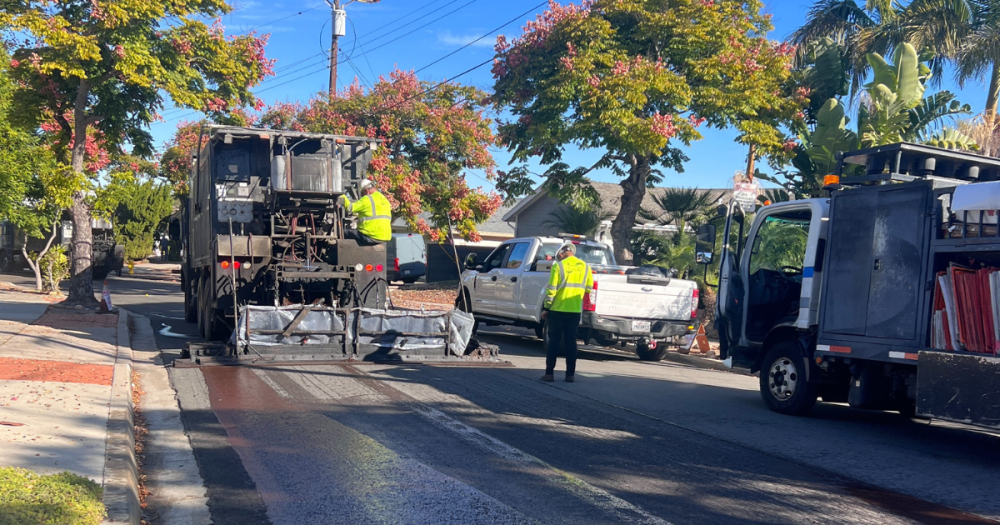Road Repair Projects Continue in Clairemont, Mira Mesa, La Jolla, Serra Mesa and University City
December 6, 2023 | City News Team

Roads are being repaired in neighborhoods across the City of San Diego as part of the Transportation Department’s ongoing Slurry Seal program. Starting this week, City crews will continue resurfacing streets in and around Clairemont, Mira Mesa, La Jolla, Serra Mesa and University City over the next three weeks.
Slurry seal is used to prevent the deterioration of streets, which is vital to improving the overall condition of San Diego’s network of roads. It reduces the need for a more costly asphalt overlay and reconstruction for badly deteriorated streets. Information about different types of street repair can be found on the Transportation webpage.
Slurry seal is often completed in phases over several days or weeks, and multiple slurry seal projects are happening across the City simultaneously. The latest work as part of Slurry Seal Project 2322 will be completed, weather permitting, through the month of December. The following roads will be resurfaced:
- Lebon Drive
- Bloch Street
- Barkla Street
- Curie Place
- Diane Court
- Diane Place
- Diane Avenue
- Soderblom Court
- Lehrer Drive
- Bothe Avenue
- Hillery Drive
- Marbury Avenue
- Acrux Drive
- Cetus Road
- Octans Street
- Volans Street
- Vela Drive
- Spica Drive
- Bellatrix Court
- Eridanus Court
- Waterton Road
- Timsford Road
- Hasbrook Road
- West Canyon Avenue
- Briar Court
- Stonecrest Boulevard
- Santo Road
- North Brookville Drive
- South Brookville Drive
- Atwood Court
- Ramsdell Court
Slurry seal is a cost-effective pavement preservation method consisting of asphalt emulsion, sand and rock. This mixture is applied to the street surface at an average thickness of a quarter inch and extends the life of already in-good-condition streets.
Streets are selected for resurfacing through a pavement management system that helps determine when to schedule streets. Each street segment is assigned an Overall Condition Index (OCI) score based on the pavement’s roughness and cracks.
To prioritize street paving, the OCI is used in conjunction with other factors, such as traffic volume, road type, equity, climate resiliency, mobility, maintenance history, other construction projects, and available funding. Repairs are often grouped within a neighborhood to include streets in similar conditions or performed after other projects, such as pipeline replacement.
View a map of street repair and other projects in your neighborhood by visiting the City’s interactive Project Finder map.
Filter by Category
Airports (1)
Arts and Culture (9)
Business (20)
City Planning (1)
Environment (46)
Human Interest (7)
Library (14)
Parks and Recreation (21)
Personnel (11)
Public Safety (20)
Public Works (58)
Streets (1)
Technology (4)
Transportation (1)
Airports (1)
Arts and Culture (9)
Business (20)
City Planning (1)
Environment (46)
Human Interest (7)
Library (14)
Parks and Recreation (21)
Personnel (11)
Public Safety (20)
Public Works (58)
Streets (1)
Technology (4)
Transportation (1)
